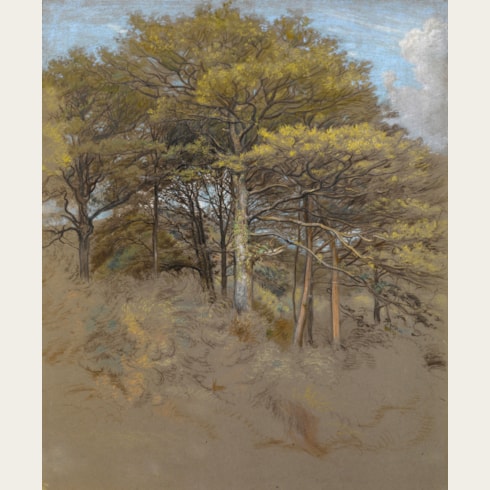James Thomas LINNELL
(Hampstead 1820 - Redhill 1905)
A Log Stack
Sold
Black chalk, with touches of white chalk on blue paper; a page from a large sketchbook.
Signed and dated J. Linnell 1865 at the lower right.
430 x 289 mm. (16 7/8 x 11 3/8 in.) [sheet]
Signed and dated J. Linnell 1865 at the lower right.
430 x 289 mm. (16 7/8 x 11 3/8 in.) [sheet]
The second son of the landscape painter John Linnell, James Thomas Linnell studied at the Royal Academy Schools alongside his two brothers John and William. (His sister Hannah married the artist Samuel Palmer, whose influence can be seen in much of James’s work.) According to a contemporary biographical dictionary, James Thomas Linnell ‘inherited not a little of his father’s talent’, although his palette was perhaps somewhat brighter. He exhibited almost annually at the Royal Academy between 1850 and 1888, at first showing religious subjects in which the landscape predominated; The Temptation in the Wilderness, exhibited in 1850, was followed a year later by Job and the Messengers. By the middle of the decade, however, he was exhibiting mainly landscapes with peasants, farm labourers or children - with titles such as Wheat-Field, Haymakers, Plowing, A Country Road and A Mower whets his Scythe - and it is for these pastoral landscapes that he is best known today. Works by James Linnell are today in the museums of Bradford, Brighton, Cardiff, Gateshead, Harrogate, Leeds, Manchester, Okehampton, Sheffield, Rochdale and Wolverhampton.
Many of James Thomas Linnell’s landscapes were painted in and around the Redstone estate at Redhill, near Reigate in Surrey, which his father John Linnell had acquired in 1851 and where all the members of the family lived. Writing in 1872, one critic noted that ‘James Thomas Linnell...is entitled to share with his brother William the estimation in which their pictures are held by the amateur and collector, sometimes rivalling even those of his father...It is so rare an occurrence to find a picture by any one of the Linnell family bearing the distinctive title of the place represented, that one would naturally be led to suppose the compositions are merely imaginary; but this, as a rule, is far from the case. Surrey, and the wealds of Sussex, supply the artists with the ground-work of most of their beautiful compositions, and the localities may generally be recognized by those who are well acquainted with them.’
Provenance
By descent in the family of the artist
Stephen Somerville, London, in 1980
Charles Ryskamp, New York.
Literature
Matthew Hargraves, Varieties of Romantic Experience: British, Danish, Dutch, French and German Drawings from the Collection of Charles Ryskamp, exhibition catalogue, New Haven, Yale Center for British Art, 2010, p.107, no.86, illustrated p.106.
Exhibition
New Haven, Yale Center for British Art, Varieties of Romantic Experience: British, Danish, Dutch, French and German Drawings from the Collection of Charles Ryskamp, 2010, no.86.








